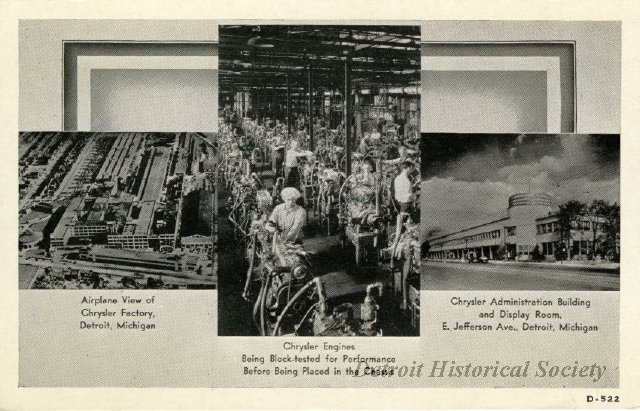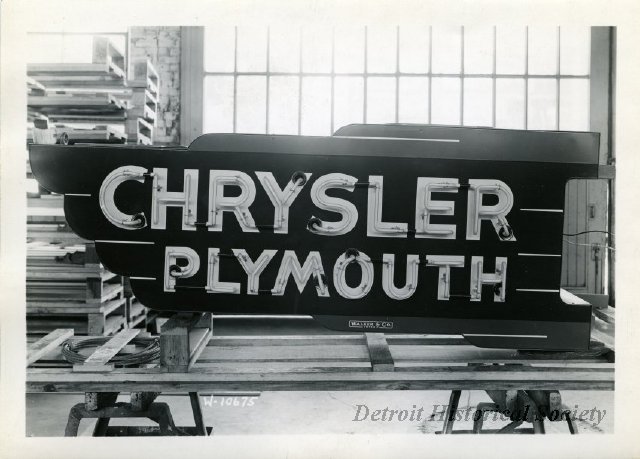On June 6, 1925, the Chrysler Corporation was officially formed by Walter P. Chrysler out of the ailing Maxwell Motor Corporation. The first Chrysler car was introduced in 1924. In 1925 the company purchased the American Motor Body Company, creating a body supply source. Chrysler began dividing its vehicles by price and function in 1928, forming the Plymouth brand for the low-end market and the DeSoto brand for the mid-range market. That same year Chrysler merged with Dodge Brothers, gaining its foundries and truck business as well as an outstanding dealer/distribution system.
In 1934, the company introduced the Airflow models, revolutionary automobiles that featured an advanced streamlined body that was tested in the industry’s first wind tunnel. However, production delays, mechanical problems and car design hindered sales - the sleek designs were not a hit with the public. As a result, styling at Chrysler remained somewhat conservative for the next two decades.
In 1935 K.T. (Kaufman Thuma) Keller, became Chrysler president, serving until 1950. Walter Chrysler remained chairman of the board until his death in 1940. Target of a sit-down strike by the United Auto Workers, the company was unionized in 1937. Car production was halted in 1942 to participate in the war effort, with Chrysler manufacturing mainly trucks, tanks, aircraft parts, guns, ammunition and bombs.
Following the war, poor design and construction contributed in part to the company dropping to the bottom of the Big Three automakers, versus Ford and General Motors. Starting with the 1960 model year, Chrysler began building its Dodge full-sized cars with Unibody constructionwhich became the industry standard for mass-produced vehicles. Also in the 1960s, the company helped create the muscle car market in the U.S., introducing a series of affordable yet high-performance vehicles that included the Plymouth Barracuda, the Plymouth Road Runner and the Dodge Charger.
In 1978 the flamboyant Lee Iacocca was appointed president of Chrysler, in an attempt to stall its sliding fortunes and reputation. During the 70s, foreign automakers and an overall economic slowdown challenged all automakers. After a tough decade, on September 7, 1979, Chrysler petitioned the U.S. government for $1.5 billion in loan guarantees in order to avoid bankruptcy. On December 21 of that year, Congress reluctantly approved the loan and within a few years, Chrysler began to slowly recover.
Still the weakest of the Big Three with a market share hovering around 11 to 14 percent, Chrysler spent much of the 1980s and 1990s repaying its loans and attempting new initiatives, like the first minivan, to ensure that the company could succeed long-term. The purchase of American Motors Company in August 1987 brought the Jeep into the Chrysler lineup. In 1998, in a move that shook the automotive industry, Daimler-Benz purchased Chrysler, forming DaimlerChrysler AG. Although initially touted as a “merger of equals,” it quickly became clear that Daimler-Benz was the dominant partner.
As Chrysler’s financial situation worsened in the early part of the 21st century, DaimlerChrysler CEO Dieter Zetsche was sent to America to turn the division around. On May 14, 2007, DaimlerChrysler AG announced that it would sell more than 80% of its stake in the Chrysler Group to Cerberus Capital Management, the firm that bought GMAC the year before, for $7.4 billion, Robert Nardelli taking the helm in August.
In February 2008, in an effort known as Project Genesis, Chrysler announced that it would begin reducing its product line and would reduce the number of dealers as well. As the financial crisis of 2008 worsened, there was talk of GM, also in trouble, and Chrysler merging but the potential job loss was a deal breaker. Despite a$4 billionloan from the U.S. government at the end of 2008,Chrysler was forced to reorganize under Chapter 11, filing for bankruptcy on April 30, 2009. A deal, which had its beginnings back in 2008, had been brokeredwith Italy’s Fiat in which U.S. and Canadian autoworkers, the Canadian government, Cerberus and Daimler (who still owned 20% of Chrysler) would own Chrysler along with Fiat, who contributed its small car technology.
After more than $10 million in government bailouts, the company emergedas Chrysler Group LLC., headed by Fiat CEO Sergio Marchionne, who strove to improve quality and product identity. When loans of $7.6 million from U.S. and Canadian governments were repaid with interest in 2011,six years ahead of schedule, the U.S. Treasury sold its Chrysler shares to Fiat at a loss of over a billion dollars. Fiat bought the remaining shares in 2014, the company becoming Fiat Chrysler Automobiles, the Chrysler subsidiary FCA US LLC.,on October 12.
In an effort to revive the brand, the Sebring was recast as the Chrysler 200 (which was later discontinued), the Chrysler 300 redesigned and in 2016 the Chrysler Pacifica name was revived as a minivan and the industry’s first electric minivan.
On January 21, 2021, FCA and Peugeot joined to become Stellantis. Still headquartered in Auburn Hills, Michigan in one of the world’s largest office buildings, Chrysler Corporation’s surviving product lines are Dodge Charger, Hornet, Challenger and Durango, RAM trucks, the Chrysler 300 and Chrysler Pacifica and Pacifica hybrid, a plug-in, and nine models of the profitable Jeep including a pick-up truck, SUVs and the celebrated Willy Jeep. Two Fiat 500 models represent Fiat.
RELATED ITEMS IN THE COLLECTION
View all items related to the Chrysler Corporation

